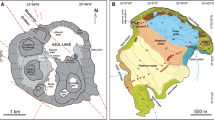Abstract
The grain size fraction less than 63 µm is an important environmental factor affecting the distribution and abundance of many of the tubificid species of Lake Constance. In substrates with a heterogeneous grain size where tubificids can be selective many species occur almost exclusively in their particle size preference range, which is highly species specific.
Similar content being viewed by others
References
Chapman, P. M. & R. O. Brinkhurst, 1984. Lethal and sublethal tolerances of aquatic oligochaetes with reference to their use as a biotic index of pollution. Hydrobiologia 115: 139–144.
Jones, J. G. & B. M. Simon, 1977. Increased sensitivity in the measurement of ATP in freshwater samples with a comment on the adverse effect of membran filtrations. Freshwat. Biol. 7: 253–260.
Moore, J. W., 1979. Influence of food availability and other factors on the composition, structure and density on a subarctic population of benthic invertebrates. Hydrobiologia 62: 215–223.
Probst, L., 1988. Die Oligochaeten im Bodensee als Indikatoren für die Belastung des Seebodens (1972 his 1978). Int. Gewässerschutzkomm. Bodensee, Ber. 38: 69 pp.
Sauter, G., 1995a. Reaktion der Tubificiden auf unterschiedliche Habitatbedingungen im Bodenseelitoral. In DGL, Erweiterte Zusammenfassung der Jahrestagung 1994 in Hamburg. H. Kaltenmeier Söhne, Krefeld-Hüls.: 354–358.
Sauter, G., 1995b. Bestimmungsschlüssel für die in Deutschland verbreiteten Arten der Familie Tubificidee mit besonderer Berücksichtigung von nicht geschlechtsreifen Tieren. Lauterbornia 23 (ISSN 0935-333X), 52 pp.
Steinlechner, R., 1987. Identification of immature tubificids (Oligochaeta) of Lake Constance and its influence on the evaluation of species distribution. Hydrobiologia 155: 57–63.
Volpers, M. & D. Neumann, 1992. Unterschiedliche Überlebensfähigkeiten von Tubificiden unter natürlichen und simulierten Profundalbedingungen eutropher Seen. Verh. dt. zool. Ges. 85: 50.
Wavre, M. & R. O. Brinkhurst, 1971. Interactions between some tubificid oligochaetes and bacteria found in the sediments of Toronto harbour, Ontario. J. Fish. Res. Bd Can. 28: 335–341.
Zahner, R., 1981. Zum biologischen Zustand des Seebodens des Bodensees in den Jahren 1972 his 1978. Int. Gewässerschutzkomm. Bodensee, Ber. 25: 289 pp.
Author information
Authors and Affiliations
Rights and permissions
About this article
Cite this article
Sauter, G., Güde, H. Influence of grain size on the distribution of tubificid oligochaete species. Hydrobiologia 334, 97–101 (1996). https://doi.org/10.1007/BF00017358
Issue Date:
DOI: https://doi.org/10.1007/BF00017358




